Kyiv Post’s Aleksandra Klitina met renowned Ukrainian artist Oleh Pinchuk to discuss how Russia’s war against Ukraine is impacting Ukrainian art, how Ukrainian artists are contributing to the war effort, and what the future bodes for Ukrainian art.
Klitina: How has the war affected Ukrainian art, including your own work, and have Ukrainian artists increased their international visibility as a consequence?
JOIN US ON TELEGRAM
Follow our coverage of the war on the @Kyivpost_official.
Pinchuk: Unfortunately – no. Art is not a priority now. Ukrainian artists are busy defending their country in Donbas. I have many friends who are in the battle zones, sometimes together with their family members. Funding has also been reduced, and museum workers have been laid off, with all resources going toward achieving military victory.
Ukrainian artists are also actively helping out on the home front by organizing exhibitions and auctions, selling Ukrainian art and donating the proceeds to Ukraine’s defense needs. But for now, the development of Ukrainian art has been put on the back burner. There has been a very sharp decrease in funding, although artists are usually not in it for the money, but rather for the work. To be part of the artistic front is very important for each of us. Today, every artist seeks to help Ukraine.
Klitina: Who are these artists who have taken up arms?
Pinchuk: Many artists have taken up arms. There is Volodymyr Gurin, who went to the front with his sons and can be seen running around in the trenches wielding a grenade launcher. And he’s not the only one. We need to achieve victory, and after that Ukrainian art can continue developing. Look around – our infrastructure is being destroyed, museums are being targeted, and there is no budget. How can we recover? Only after victory and using Russian assets seized abroad.
Museums like that of Skovoroda (in Kharkiv Region) and Pryimachenko (in Kyiv Region) have been destroyed and need to be rebuilt, and the best specialists and architects have to be involved. I would like to see the renowned architect Norman Foster get involved in the restoration of the Pryimachenko museum. We have been organizing auctions in Cannes, also online auctions. The prices are somewhat inflated … but everyone understands that the money is going toward support of the Ukrainian army. Our culture has always been financed on a residual basis, and now even more so.
Klitina: Does censorship exist in Ukrainian art? Is it hard for young artists to get a start?
Pinchuk: There is not the kind of censorship that existed in the Soviet Union. Every artist does what he wants, but it’s a question of whether a young artist can make a living from it. Will the artist be able to survive and still remain true to his inspiration? We still need to adapt to the rules of the art market and of society.
You can’t be too vulgar, and if it is vulgar, it should be provocatively so. There are many different things to consider – international art, regional art and niche art in each country.
And there has to be connections to leading international institutions in the art world – international exhibitions, fairs and auction houses. Unfortunately, Ukrainian venues are not as successful as those of other countries. For example, Maria Pryimachenko’s paintings are not highly valued, while works in the same style by Henri Rousseau cost millions and millions of euros.
Klitina: Let’s talk about your work. Last year, a statue to the young [Ukrainian poet] Taras Shevchenko was unveiled in Florence, Italy – a significant event for Ukrainian culture. What other works do you consider to be of importance?
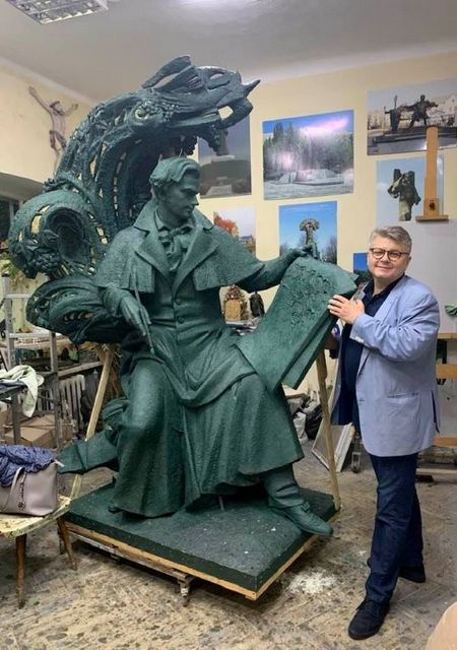 Pinchuk and sculpture of Ukrainian national poet Taras Shevchenko
Pinchuk and sculpture of Ukrainian national poet Taras Shevchenko
Pinchuk: The Shevchenko statue is the work of a creative team of friends. It is a collaborative effort. The statute had to be designed, manufactured, transported and installed. I have many such monumental works – a statue to Ukrainian freedom fighters, which is of greater significance than the monument to Peter the Great in St. Petersburg. It stands in Dubno, Rivne Region, a place of Cossack glory.
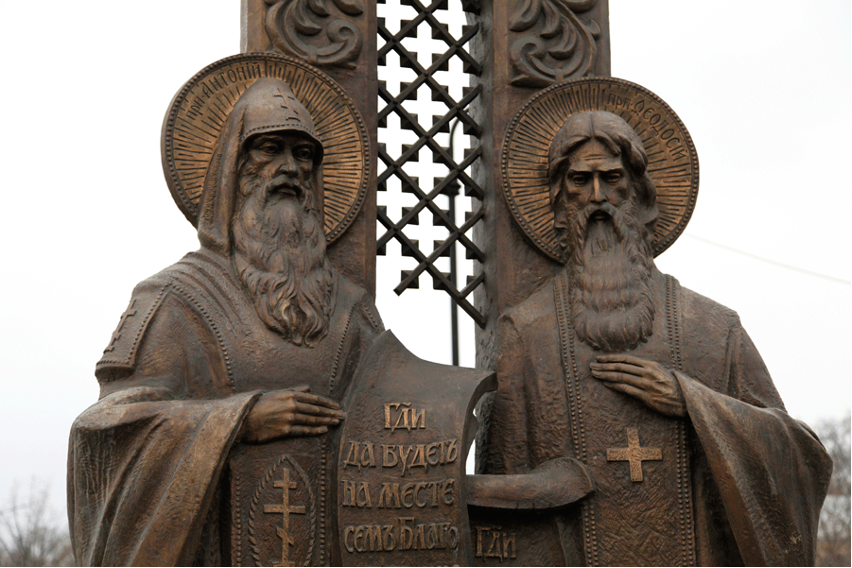 Monument to Anthony and Theodosius – founders of Ukraine’s Kyiv Pechersk Lavra
Monument to Anthony and Theodosius – founders of Ukraine’s Kyiv Pechersk Lavra
I have also created a monument to memorialize the fight against AIDS, which stands in Kyiv, and one to Antonia and Feodosia, who founded the Medieval Kyiv Pechersk Lavra. These were also collaborations and a lot of work. It’s difficult to do things like this on one’s own, and nice when one can work with his friends.
Klitina: A lot of your work features horns. What is their significance?
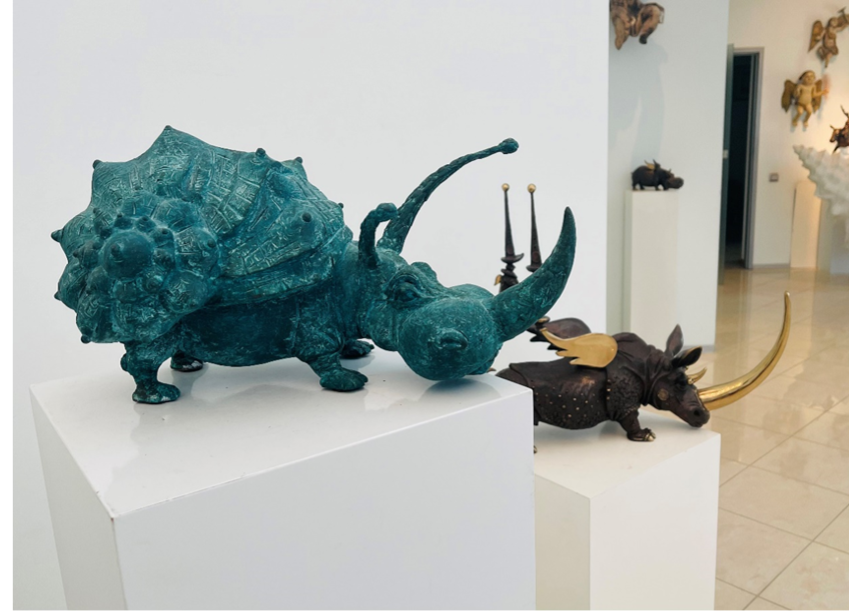 One of Pinchuk’s many sculptures featuring ‘horns’
One of Pinchuk’s many sculptures featuring ‘horns’
Pinchuk: Everyone has his own vision. I’m very positive. There are a lot of horns in my work, but they are nice horns. Children love these sculptures. They come to take photos, and their parents buy these works. My creatures are in many prestigious collections. I’ve worked with brands such as Cartier, exhibited in Monaco and done many museum projects. Some of my works have been purchased by Cardin. My artworks are used in the manufacture of Bovet watches. It’s a very famous brand.
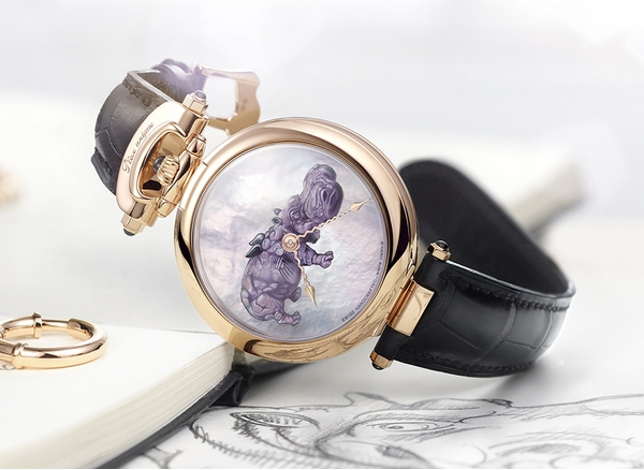 Famous Swiss time piece maker Bovet uses images of fantastic animals created by Oleh Pinchuk on the faces of its watches
Famous Swiss time piece maker Bovet uses images of fantastic animals created by Oleh Pinchuk on the faces of its watches
Klitina: Can you share any humorous anecdotes about your work? I’ve heard that President Zelensky saw the face of Vladimir Putin in some of your art. I took a look myself, but only one sculpture seemed to me to bear any resemblance to Putin.
Pinchuk: That was a long time ago when Zelensky asked me this, but I do not make portraits of Putin or anyone else. I love freedom and the creation of images that I like. Someone can see Putin or Medvedev or anyone else in my work, but these are not portraits.
Klitina: Perhaps Volodymyr [Zelensky] subconsciously saw his future opponent and enemy in your works?
Pinchuk: Maybe. At one time I helped him hold several charity auctions. At the time, our elite did not want to buy clothes from Ukrainian designers at auctions. Volodymyr and I arranged things so that the entire collection was sold. We raised more than 600,000 euros to help children.
Then, to contribute myself, I bought a tie and a sweater from Zelensky and gave the tie to an oligarch, Borys Fuchsman, who then bought a dress by Ukrainian designer Diana Dorozhkina for a large amount.
Klitina: Has there been a particular customer or buyer who made an impression on you?
Pinchuk: Yes, about 20 years ago. One man came and said: ‘All my life I have dreamed of buying your work. Now I am rich and can afford it.’ I, in turn, told him that I would, of course, give him a discount. He came in with the money wrapped in newspaper, wrapped my work in the same newspaper and left. I told him: ‘Here is your discount. Take some of this money back.’ But he said, ‘No need.’
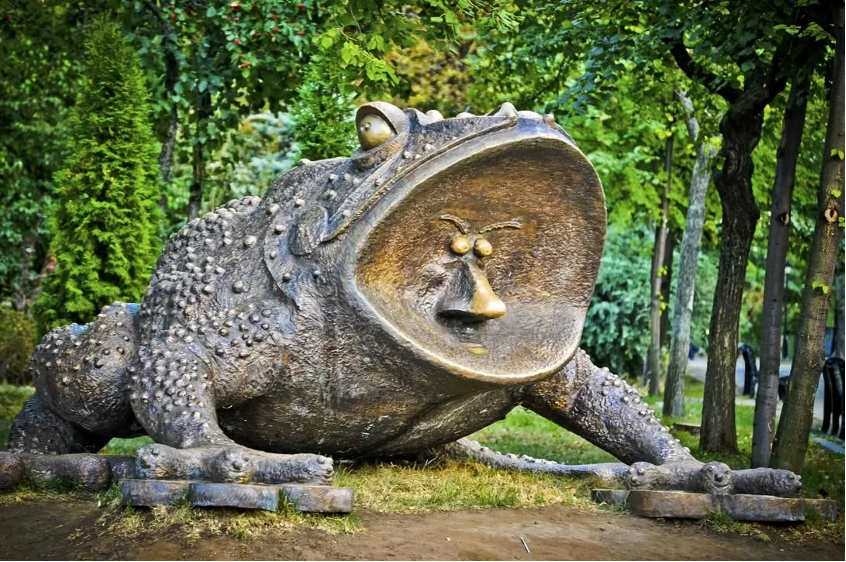 Pinchuk’s Kyiv Frog statue at Mariinsky Park in Kyiv
Pinchuk’s Kyiv Frog statue at Mariinsky Park in Kyiv
There is also the Kyiv Frog statue, in Mariinsky Park, which people throw money into. Some homeless people made a hole in it and hooked up a device to take the money out. I met one of them and he asked me: ‘Is this your frog? If it is, thank you. I came to Kyiv without any money and was able to survive for a couple of weeks on the money I got from this frog.’ People throw in the money and rub the frog’s nose. Others take money out. That’s the way it works.
I like the fact that kids love my creations and that I work a lot with foreign investors and collectors. In this way I convey the spirit of Ukrainian art – I mean Ukrainian artists who have changed perceptions of contemporary art. For example, Ukrainian artist Kazimir Malevich and his black square. Why was he so successful, becoming a brand, an artifact of the 20th-century. Ukrainians have created a lot.
Now the Russians want to make us into a tributary. The Russians come here and get pleasure from stealing a toilet from someone’s home. It’s digusting. They want to instill this culture of barbarity in Ukraine. It won’t work. We saw what happened in Bucha. We saw what happened in Gostomel and Donbas are. Defeat is not an option!
Klitina: International interest in Ukrainian art is growing, even if it is to help Ukraine. Are there any exhibits or auctions lined up? Can you give me a head up on them?
Pinchuk: I think that a distinction should be made between professional art and other types. Because, for example, people buy a painting at an auction for a hundred dollars and then hang it up next to a work by a Ukrainian master that they don’t even look at. Ukrainian artists in the world are largely underestimated, except for Maria Primachenko. She is popular among a lot of collectors these days. There is interest, but there isn’t a clear structure for Ukrainian art to be integrated into the international art market. It’s a very complex process. It’s not just sculpting a sculpture or painting a portrait, it’s very painstaking work. There are difficulties, but competition among Ukrainian artists is average.
I plan to develop in the European market. I have a good position. I studied there and worked with international collectors, but unfortunately or fortunately, there is still much to be done.















